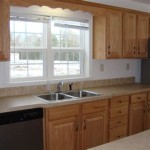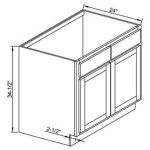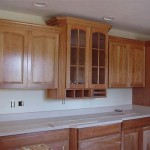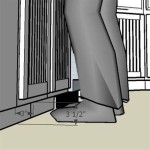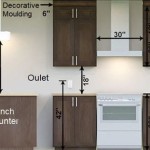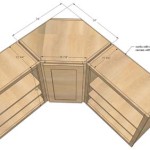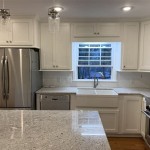Replacing Kitchen Craft Cabinet Doors: A Comprehensive Guide
Kitchen Craft cabinetry is a ubiquitous feature in many homes, renowned for its durability and stylish design. However, even the most robust kitchen cabinets can show wear and tear over time. The cabinet doors, being the most visible and handled components, are often the first to exhibit signs of damage, fading, or outdated aesthetics. Fortunately, replacing Kitchen Craft cabinet doors offers a cost-effective alternative to a complete kitchen remodel, allowing homeowners to refresh their kitchen's appearance without incurring significant expenses. This article provides a comprehensive guide to replacing Kitchen Craft cabinet doors, covering essential considerations, practical steps, and potential challenges.
Before embarking on the replacement project, a thorough assessment of the existing Kitchen Craft cabinetry is crucial. This assessment should encompass the identification of cabinet styles, door dimensions, hinge types, and overall cabinet condition. Accurate measurements are paramount for ensuring a seamless fit with the new doors. Furthermore, understanding the existing kitchen's design aesthetic is essential for selecting replacement doors that complement the overall décor.
Key Point 1: Assessing Your Existing Kitchen Craft Cabinetry
The initial stage of replacing cabinet doors involves a detailed evaluation of the existing Kitchen Craft cabinetry. This assessment serves multiple purposes, including identifying the correct replacement door style, determining accurate measurements, and recognizing potential installation challenges.
Firstly, determining the cabinet style is crucial. Kitchen Craft offers a variety of cabinet styles, each with unique design features. Understanding the specific style of your existing cabinets will help in selecting replacement doors that seamlessly integrate with the existing framework. Consider the door's construction, panel style (raised, flat, or recessed), and edge detailing. Photographs of the existing doors can be invaluable during the selection process.
Secondly, accurate measurements are paramount. Cabinet door sizes can vary slightly, even within the same cabinet line. Measurements should be taken with precision, using a measuring tape that is accurate to at least 1/16th of an inch. Measure the height and width of each door individually, as they may not all be identical. Label each door with its corresponding cabinet location to avoid confusion during installation. Include the thickness of the door as well, as this can affect hinge compatibility.
Thirdly, identifying the hinge type is essential for ensuring compatibility with the new doors. Kitchen Craft cabinets often utilize different types of hinges, including concealed (European-style) hinges and face-frame hinges. Examine the existing hinges to determine their type and configuration. Note the hinge overlay, which refers to the amount the door covers the cabinet frame when closed. This overlay measurement is critical for selecting replacement hinges that provide the correct fit.
Finally, assess the overall condition of the cabinet boxes. Ensure that the boxes are structurally sound and free from significant damage or warping. If the cabinet boxes are damaged, replacing the doors alone may not be sufficient to achieve the desired aesthetic improvement. Addressing any structural issues with the cabinet boxes before installing the new doors is crucial for a long-lasting and visually appealing result.
Once the assessment is complete, the next step involves selecting the appropriate replacement doors. Considerations should include material, style, finish, and the supplier from whom the doors will be purchased. Opting for high-quality materials and finishes will ensure durability and enhance the overall appearance of the kitchen.
Choosing a reputable supplier is equally important. A reputable supplier will offer a wide selection of door styles, materials, and finishes, as well as provide expert advice and support. They should also offer options for pre-drilled hinge holes and custom sizing to ensure a perfect fit. Consider reading online reviews and comparing prices from different suppliers before making a final decision.
Key Point 2: Selecting Replacement Doors and Hardware
The selection of replacement doors and hardware is a pivotal step in the cabinet door replacement process. This decision significantly impacts the aesthetic appeal, functionality, and longevity of the refreshed kitchen cabinets. Careful consideration of material, style, finish, and hardware is essential for achieving the desired outcome.
Regarding material, several options are available, each with its own advantages and disadvantages. Solid wood offers a classic and durable choice, but it can be more expensive and susceptible to warping in humid environments. Wood veneer over a core material provides a cost-effective alternative with a similar appearance to solid wood. Thermofoil doors, constructed from a heat-sealed vinyl laminate over a medium-density fiberboard (MDF) core, are durable, easy to clean, and resistant to moisture. Laminate doors offer another budget-friendly option, known for their scratch resistance and ease of maintenance. The choice of material should be based on budget, desired aesthetic, and environmental considerations.
Door style is another crucial aspect to consider. The style of the doors should complement the overall design of the kitchen. Shaker-style doors, with their simple and clean lines, are a popular choice for contemporary and transitional kitchens. Raised-panel doors offer a more traditional and ornate look. Flat-panel doors provide a minimalist and modern aesthetic. Consider the existing architectural style of the home and the overall design theme of the kitchen when selecting a door style.
The finish of the doors plays a significant role in their appearance and durability. Painted finishes offer a wide range of color options and can be easily updated to reflect changing trends. Stained finishes showcase the natural grain of the wood and provide a warmer, more traditional look. Consider the existing color scheme of the kitchen and the desired level of maintenance when selecting a finish. High-quality finishes will resist chipping, scratching, and fading, ensuring that the doors maintain their appearance for years to come.
Selecting appropriate hardware, including hinges and knobs or pulls, is also essential. Hinges should be compatible with the chosen door and cabinet frame. Concealed hinges offer a clean and modern look, while face-frame hinges are more traditional. Knobs and pulls should complement the style of the doors and be comfortable to use. Consider the finish of the hardware and its durability. Select hardware that is resistant to corrosion and wear.
Upon receiving the new cabinet doors, a careful inspection is necessary to ensure they meet the specified requirements and are free from any defects. Verify the dimensions, style, finish, and hardware placement. Address any discrepancies with the supplier before proceeding with the installation.
The installation process typically involves removing the old doors, installing the new hinges (if necessary), attaching the new doors to the cabinet frames, and adjusting the hinges to ensure proper alignment. Precision and attention to detail are crucial for achieving a professional-looking result.
Key Point 3: Installing the New Kitchen Craft Cabinet Doors
The installation phase requires meticulous attention to detail and a systematic approach to ensure a seamless and professional outcome. Proper installation not only enhances the aesthetic appeal of the kitchen but also guarantees the functionality and longevity of the new cabinet doors.
The first step involves carefully removing the existing cabinet doors. This should be done with caution to avoid damaging the cabinet frames. Using a screwdriver, detach the hinges from the cabinet frame. Save the screws, as they may be useful for installing the new hinges. Once the hinges are detached, carefully lift the door away from the frame.
Next, prepare the new doors for installation. If the new doors are pre-drilled for hinges, ensure that the holes align with the existing hinge locations on the cabinet frames. If the doors are not pre-drilled, use a template or measuring tools to accurately mark the locations for the hinge screws. Pre-drilling pilot holes will prevent the wood from splitting and make installation easier.
Attach the hinges to the new doors. Use the screws previously removed from the old doors, or new screws if necessary. Ensure that the hinges are securely fastened to the doors and that they are aligned correctly. The correct alignment of the hinges is crucial for ensuring that the doors open and close smoothly.
Attach the new doors to the cabinet frames. Align the hinges on the door with the corresponding locations on the cabinet frame. Use a screwdriver to attach the hinges to the frame. Tighten the screws securely, but avoid over-tightening, as this can damage the wood. Check the alignment of the door and adjust the hinges as needed. Many hinges offer adjustments that allow for fine-tuning the door's position.
Once the doors are installed, inspect them for proper alignment and functionality. Ensure that the doors open and close smoothly and that they are flush with the cabinet frames when closed. Adjust the hinges as necessary to achieve the desired alignment. Minor adjustments can often make a significant difference in the overall appearance and functionality of the cabinets.
Finally, install the knobs or pulls. Use a template to accurately mark the locations for the hardware. Drill pilot holes if necessary. Attach the knobs or pulls to the doors using the appropriate screws. Ensure that the hardware is securely fastened and that it is comfortable to use.
Throughout the installation process, it is crucial to maintain a clean and organized workspace. Protect the surrounding surfaces from scratches and damage. Use drop cloths to protect the flooring. Clean up any debris or spills immediately. Take breaks as needed to avoid fatigue and maintain focus. If encountering any difficulties during the installation process, consult with a professional for assistance.
Following these steps carefully will ensure a successful Kitchen Craft cabinet door replacement, resulting in a refreshed and updated kitchen aesthetic.

10 Simple Ideas To Update Your Kitchen Cabinets Jenna Sue Design

25 Easy Ways To Update Kitchen Cabinets

Best Kitchen Cabinet Refacing For Your Home The Depot

How Much Does It Cost To Replace Kitchen Cabinet Doors

All About Replacing Cabinet Doors New

How To Replace Kitchen Cabinet Doors

Can You Replace Just The Cabinet Doors Now

10 Simple Ideas To Update Your Kitchen Cabinets Jenna Sue Design

25 Easy Ways To Update Kitchen Cabinets

25 Easy Ways To Update Kitchen Cabinets
Related Posts

